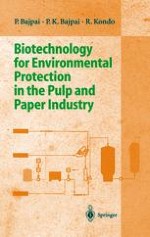1999 | OriginalPaper | Chapter
Treatment of Wastewaters with Anaerobic Technology
Authors : Dr. Pratima Bajpai, Dr. Pramod K. Bajpai, Prof. Dr. Ryuichiro Kondo
Published in: Biotechnology for Environmental Protection in the Pulp and Paper Industry
Publisher: Springer Berlin Heidelberg
Included in: Professional Book Archive
Activate our intelligent search to find suitable subject content or patents.
Select sections of text to find matching patents with Artificial Intelligence. powered by
Select sections of text to find additional relevant content using AI-assisted search. powered by
The forest industry utilizes wood and other lignocellulosic feedstocks as raw materials for the production of paper. The major constituents of wood are cellulose, hemicellulose, lignin, and extractives. Softwoods, hardwoods, and straw have different proportions of chemical components (Table 7.1). The processing of wood in paper mills involves various operations including debarking, pulping, and bleaching that result in the discharge of highly polluted wastewaters. The quantity and types of pollutants in these effluents vary with the type of lignocellulosic feedstock used as raw material, the process conditions applied (pH, temperature, pressure, chemical and mechanical treatments), and the specific water consumption.1 Chemical additions and, to a lesser extent, high pressures and temperatures result in an increased release of organic matter into the process water and extensive lignin solubilization. Therefore, the pollution loads and the color due to dissolved lignin compounds is very high for chemical as compared to mechanical pulping effluents.2,3 The COD loads associated with mechanical pulping processes range from 20–50 kg COD/ton of pulp whereas those corresponding to soda pulping processes may be as high as 500–900 kg COD/ton of pulp.1,4 Nevertheless, the black liquors originating from kraft and soda processes are usually burnt to recover the pulping chemicals and the calorific power from the organic components, diminishing to a great extent, the environmental impact associated with these pulping processes. Conventional recovery processes are not economically viable in small paper mills and in those using nonwoody raw materials with a high silica content.4,5 Black liquors represent a very important pollution source in several countries where small-scale mills are common.4-6
